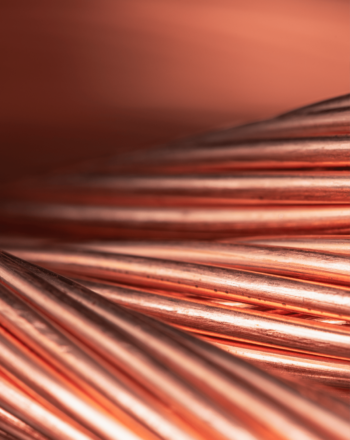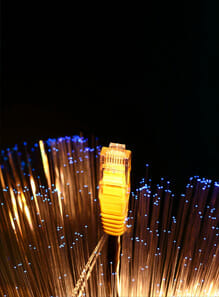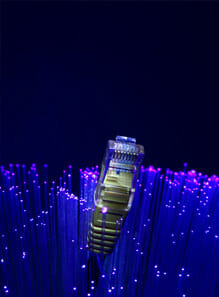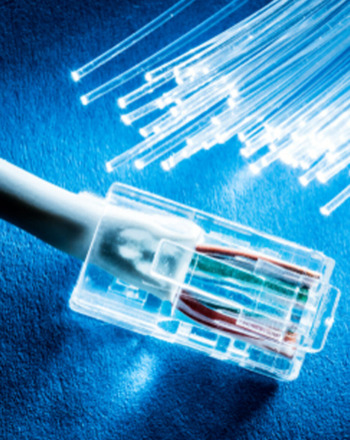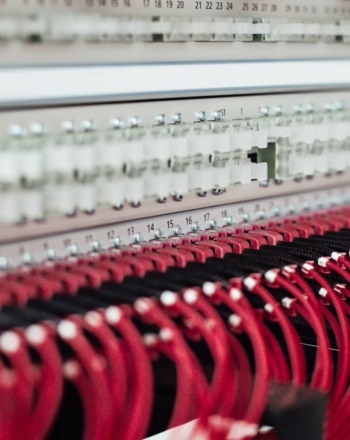Ethernet is a networking technology that allows devices to communicate with each other over a wired connection. It is widely used in modern networking to connect computers, servers, and other devices to each other and to the internet. Ethernet is important because it provides a reliable, high-speed connection that is essential for many businesses and organizations.
In this article, we will cover several diverse types of Ethernet cables, including Cat 5 Ethernet, Cat 6 Ethernet, Cat 7 Ethernet, and Single Pair Ethernet. We will also discuss the benefits of Industrial Ethernet and how it can enhance your network infrastructure. Additionally, we will explore the benefits of using Power over Ethernet, and how Ethernet outlets can improve connectivity in your business.
Cat 5 Ethernet
Cat 5 Ethernet is a type of Ethernet cable that is commonly used in networking applications. It was first introduced in the 1990s and has since become one of the most popular types of Ethernet cables on the market.
Cat 5 Ethernet cables have a maximum frequency of 100 MHz and are capable of transmitting data at speeds of up to 1000 Mbps (megabits per second). They use four pairs of twisted copper wire to transmit data, with each pair responsible for transmitting a different signal.
Cat 5 Ethernet cables are commonly used in a variety of industries, including telecommunications, industrial automation, and building automation. They are also commonly used in residential and small business networking applications.
The speeds achieved by Cat 5 Ethernet cables make them suitable for a wide range of applications, including internet browsing, email, and basic file transfers. However, they may not be suitable for applications that require higher bandwidth or faster data transfer rates, such as video streaming or large file transfers.
Cat 6 Ethernet
Cat 6 Ethernet is a type of Ethernet cable that was introduced in the early 2000s as an upgrade to the Cat 5 Ethernet standard. It is designed to provide faster data transfer speeds and better resistance to crosstalk and interference.
Cat 6 Ethernet cables have a maximum frequency of 250 MHz and are capable of transmitting data at speeds of up to 10 Gbps (gigabits per second) over distances of up to 55 meters. They use four pairs of twisted copper wire, just like Cat 5 Ethernet, but with tighter twists and better insulation.
Cat 6 Ethernet cables are commonly used in a variety of industries, including data centres, video production, and medical imaging. They are also commonly used in residential and small business networking applications where higher bandwidth and faster data transfer speeds are required.
The speeds achieved by Cat 6 Ethernet cables make them suitable for a wide range of high-bandwidth applications, such as video streaming, large file transfers, and online gaming. They are also ideal for use in environments where interference from other electronic devices may be a concern.
Cat 7 Ethernet
Cat 7 Ethernet is a newer type of Ethernet cable that was introduced in the early 2010s. It is designed to provide even faster data transfer speeds and better resistance to crosstalk and interference than Cat 6 Ethernet.
Cat 7 Ethernet cables have a maximum frequency of 600 MHz and are capable of transmitting data at speeds of up to 10 Gbps over distances of up to 100 meters. They use four individually shielded twisted pairs of copper wire, which provides better resistance to interference and crosstalk.
Cat 7 Ethernet cables are commonly used in a variety of industries, including aerospace, automotive, and telecommunications. They are also commonly used in data centres, server rooms, and other environments where high-speed data transfer and reliability are critical.
The speeds achieved by Cat 7 Ethernet cables make them ideal for high-bandwidth applications such as streaming 4K video and online gaming. They are also ideal for use in environments where electromagnetic interference (EMI) and radio frequency interference (RFI) may be present, as the shielding in the cables provides better protection against these types of interference.
Single Pair Ethernet
Single Pair Ethernet (SPE) is a type of Ethernet that uses a single pair of wires instead of the four pairs used in traditional Ethernet cables. SPE is designed to provide Ethernet connectivity to devices that do not require the high bandwidth or long distances that traditional Ethernet is designed for.
SPE differs from other Ethernet types in several ways. First, it uses a single pair of wires instead of the four pairs used in traditional Ethernet cables. This reduces the size and weight of the cable, making it ideal for use in compact devices and industrial applications where space is at a premium. Second, SPE uses power over Ethernet (PoE) to provide power to devices, eliminating the need for separate power cables. Finally, SPE supports longer cable runs than other types of Ethernets, up to 1,000 meters.
Single Pair Ethernet is commonly used in industries such as automotive, manufacturing, and building automation, where there is a need for Ethernet connectivity in space-constrained or harsh environments. It is also becoming more popular on the Internet of Things (IoT) industry, where devices need to be small and energy efficient.
SPE works by transmitting data and power over a single pair of wires. The wires are typically twisted together to reduce interference and crosstalk. SPE uses a technique called pulse amplitude modulation (PAM) to transmit data over the wires. PAM modifies the amplitude of the pulse to represent data, allowing for high-speed data transmission over the single pair of wires. The PoE technology used in SPE provides power to devices over the same pair of wires, reducing the need for additional power cables.
Power over Ethernet Cable
Power over Ethernet (PoE) is a technology that allows network cables to carry electrical power. This means that Ethernet cables can be used not only for data transmission but also for powering devices that are connected to the network. PoE eliminates the need for separate power cables, making it a more efficient and cost-effective solution for powering network devices.
PoE works by using a PoE-enabled switch or injector to send power over the Ethernet cable along with data. The power is delivered to the device through the Ethernet cable's unused wires, while the data is transmitted over the other wires.
PoE can be applied to various technologies, including VoIP (Voice Over Internet Protocols) phones, IP (Internet Protocol) cameras, wireless access points, and network switches. It eliminates the need for separate power sources for these devices, simplifying installation and reducing costs.
The benefits of using PoE are numerous. It reduces the number of cables needed, making installation more straightforward and reducing clutter. It also provides a more reliable and efficient power source, as devices can be centrally powered and managed. In addition, PoE can be used to power devices in hard-to-reach locations, such as ceiling-mounted wireless access points or security cameras, without requiring a nearby power outlet.
Overall, PoE is a convenient and cost-effective solution for powering network devices. It simplifies installation, reduces clutter, and provides a reliable and efficient power source for devices on the network.
Industrial Ethernet
Industrial Ethernet is a type of Ethernet that is specifically designed for use in industrial environments. It differs from standard Ethernet in several ways, including its robustness, reliability, and ability to withstand harsh environmental conditions.
One of the main benefits of using Industrial Ethernet in a business environment is its reliability. Industrial Ethernet is designed to be more robust and resilient than standard Ethernet, which is important in environments where downtime can be costly. Industrial Ethernet is also able to withstand harsh environmental conditions, such as extreme temperatures, moisture, and vibrations, which makes it ideal for use in industrial settings.
Industrial Ethernet is commonly used in industries such as manufacturing, oil and gas, transportation, and utilities, where there is a need for reliable and robust communication systems. In these industries, communication systems are critical for controlling processes, monitoring equipment, and ensuring safety.
In addition to its robustness and reliability, Industrial Ethernet also offers other benefits for businesses. For example, it allows for remote monitoring and control of equipment, which can increase efficiency and productivity. It also enables the use of real-time data for monitoring and control, which can lead to improved decision-making.
Overall, Industrial Ethernet is an important technology for businesses operating in industrial environments. Its robustness, reliability, and ability to withstand harsh conditions make it ideal for use in industries where communication systems are critical. By adopting Industrial Ethernet, businesses can improve efficiency, productivity, and safety, while reducing downtime and maintenance costs
Ethernet Outlets
Ethernet outlets are physical connections that allow devices to connect to an Ethernet network. They are commonly found in homes and businesses and provide a simple and reliable way to connect devices to the internet and other network resources.
Ethernet outlets work by transmitting data over Ethernet cables, which are connected to the outlet. When a device is connected to the outlet, it sends and receives data through the cable, allowing it to access the network and communicate with other devices.
The benefits of using Ethernet outlets in a business environment are numerous. Ethernet outlets provide a more reliable and secure connection than wireless networks, which can be susceptible to interference and hacking. They also offer faster speeds and lower latency, which is important for applications such as video conferencing and online gaming.
There are several types of Ethernet outlets available, including wall plates, modular jacks, and keystone jacks. Wall plates are fixed to the wall and typically have one or more Ethernet ports, while modular jacks and keystone jacks are designed to be inserted into patch panels or wall plates.
Overall, Ethernet outlets are a vital component of network infrastructure in both homes and businesses. They provide a simple and reliable way to connect devices to a network and offer numerous benefits over wireless networks. By choosing the right type of Ethernet outlet for their needs, businesses can ensure that their network is reliable, secure, and high performing.
Conclusion
In this article, we have covered several diverse types of Ethernet cables, including Cat 5, Cat 6, Cat 7, and Single Pair Ethernet. We have discussed the technical specifications, industries where they are commonly used, and the speeds achieved by each type of cable. We have also covered Industrial Ethernet and Ethernet outlets, two important components of network infrastructure.
Having a solid Ethernet infrastructure in a business environment is essential in today's world. It allows for fast, reliable, and secure communication between devices, which is crucial for many business operations. Ethernet cables offer faster speeds and lower latency than wireless networks, and they are less susceptible to interference and hacking.
Industrial Ethernet is designed to withstand harsh environments and provide reliable connectivity in industrial settings. Ethernet outlets offer a simple and reliable way to connect devices to a network, and they offer numerous benefits over wireless networks.
Overall, a solid Ethernet infrastructure can help businesses increase productivity, streamline communication, and reduce downtime. By investing in the right Ethernet technologies and components, businesses can ensure that their network is reliable, secure, and high performing.






















